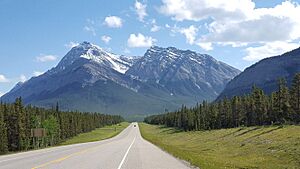Elliott Peak facts for kids
Quick facts for kids Elliott Peak |
|
|---|---|

Elliott Peak and the David Thompson Highway seen from Abraham Mountain
|
|
| Highest point | |
| Elevation | 2,873 m (9,426 ft) |
| Prominence | 453 m (1,486 ft) |
| Parent peak | Mount Cline (3361 m) |
| Listing | Mountains of Alberta |
| Geography | |
| Location | Alberta, Canada |
| Parent range | Canadian Rockies |
| Topo map | NTS 83C/01 |
| Type of rock | Sedimentary |
| Climbing | |
| First ascent | 1906 Elliott Barnes Jr. |
Elliott Peak is a tall mountain located in the beautiful Canadian Rockies of Alberta, Canada. It stands 2,873 meters (about 9,426 feet) high. This impressive peak is found in the North Saskatchewan River valley.
You can easily see Elliott Peak from the David Thompson Highway and Abraham Lake. Water from the mountain flows into streams that eventually join the Saskatchewan River. The closest higher mountain to Elliott Peak is Mount Cline, which is about 16 kilometers (10 miles) to the southwest. Right next to Elliott Peak, you'll find Mount Ernest Ross.
Mountain History
Elliott Peak was first called Sentinel Peak in 1892 by Arthur Coleman. Today, a nearby part of the mountain, about 1.6 kilometers (1 mile) to the northwest, is named Sentinel Mountain.
The mountain was renamed in 1907 to honor Elliott Barnes Jr. His father, Elliott Barnes Sr., owned a ranch in the North Saskatchewan valley. Elliott Jr. was only eight years old when he became the first person to climb the peak in 1906.
The name "Elliott Peak" became official in 1924. This was decided by the Geographical Names Board of Canada.
How the Mountain Formed
Elliott Peak is made of sedimentary rock. This type of rock forms from layers of sand, mud, and tiny bits of sea creatures that settle at the bottom of ancient seas. These layers were laid down over millions of years, from the Precambrian to the Jurassic periods.
Later, during a time called the Laramide orogeny, powerful forces deep within the Earth pushed these rock layers. This movement caused the sedimentary rock to fold and lift, creating the mountains we see today.
Mountain Climate
Elliott Peak is located in a subarctic climate zone. This means the area has very cold and snowy winters. Summers are usually mild.
During winter, temperatures can drop below -20 degrees Celsius (-4 degrees Fahrenheit). With the wind chill, it can feel even colder, sometimes below -30 degrees Celsius (-22 degrees Fahrenheit).




